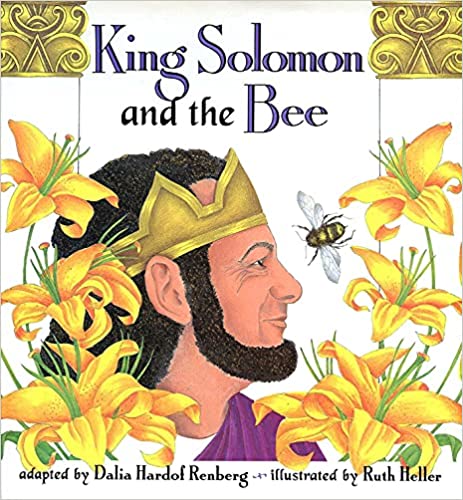For many years, children have been charmed by the adaptation of the classic tale of King Solomon and an oh-so-smart bee. In King Solomon and the Bee by Dalia Hardof Renberg and illustrated by Ruth Heller, the clever bee helps King Solomon solve a riddle posed by the Queen of Sheba. The book was originally published in 1994 by HarperCollins. To the delight of teachers and librarians, a paperback edition of King Solomon and the Bee was recently published by Interlink Publishing. Dalia is also the author of The Complete Family Guide to Jewish Holidays and another children’s picture book, Hello, Clouds. I’m thrilled that Dalia was able to answer a few questions about her classic book.
What inspired you to write King Solomon and the Bee?
I always liked the story. One day, I wanted to tell my first grandchild, Aaron, some Israeli and Jewish children’s stories. I was mentally collecting such stories, when I remembered, all of a sudden, the Bee story. After looking around and not finding it in English for children, I did some research, including about the rights to the story, and concluded that I should write a children’s version.
I wrote it on speculation and showed it to my editor at HarperCollins, who liked it very much. Knowing that I’m an artistic type, she allowed me to participate in the search for an illustrator, which, of course, is unusual. Most editors don’t like to involve the writer until the very end. When she asked how I felt about Ruth Heller, I was delighted.
The book is newly released in paperback. Can you share a bit about this process?
Publishers have a formula to which I am not privy. The essence of it is that a certain number of books have to be sold in a certain time frame. If the sales don’t reach the desirable number, publishers don’t come out with a paperback edition. This was the case, anyway, many years ago when my editor left HarperCollins, and the book became an orphan. In spite of the fact that the book got good reviews, there was not anybody to push it. Since there were not enough sales, the book was cancelled. For years, I wanted to revive it but could not until I heard about The PJ Library. At a conference for writers who write about Jewish subjects, I heard a lot about their great program of publishing and giving free books to Jewish families. I submitted the book, and it was accepted. They ordered copies of a special edition, but I made sure that the publisher would print more copies of the regular edition for the general public.

What is the best part of being an author of children’s books?
I get the most pleasure when I see the children’s responses in person. Hearing a child using his/her imagination while looking at clouds after hearing my story ”Hello, Clouds!” is very rewarding. Hearing a child asking questions about Jewish holidays after being read to, or after using my “Complete Family Guide to Jewish Holidays” is heartwarming. So is a child telling me a riddle that the queen should have asked the king. Watching children’s delight when hearing the cheeky little bee talking to Solomon is really amusing.
What is your favorite holiday?
It might surprise you, but it is a somewhat minor, obscure holiday: La’g Ba’omer. It is not mentioned in the Bible, and, therefoe there is speculation about its origin. Whatever the facts, as children in Israel we celebrated it in ways that left me with sweet memories. On the eve of the holiday, we children walked in a parade (organized by youth movements), holding torches which we made that afternoon. We ended up in a field where a huge bone fire was created. After that we danced the Hora and other dances around it. Later, when the fire subsided somewhat, we baked potatoes in it. Each child had a stick with a nail at the end to pick up the hot potatoes. We did not have marshmallows in those days. This kind of celebration was repeated in empty fields all over the country. The next day, instead of school, we went on a picnic with the teachers. We brought with us hard boiled eggs, which we had decorated in school or at home, and played many relay games and shot things with bows and arrows, which we made from tree branches.
Dalia, thanks for stopping by to share the buzz about your book!